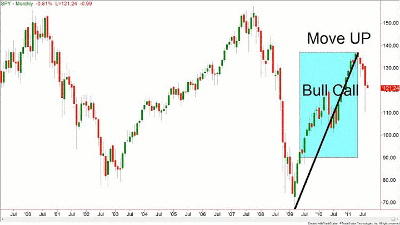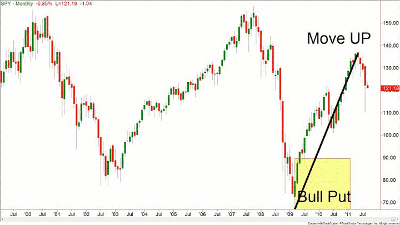The difference between credit and debit spreads, and how they relate to each phase of an uptrend or downtrend, can be very important to the success of these trades.
A question that is often raised in the class when the topic of verticals is being taught is: When is the best time to do credit spreads versus debit spreads?
The correct answer is simple: When the implied volatility (IV) is high, do credit spreads, and when the IV is low or within a lower range, do debits. Although that is the correct answer, there is more to it than this gross oversimplification: Sell the spread when the IV is high, and buy the spread when the IV is low.
An additional issue that needs to be addressed is: what is truly happening on the chart directionally? It is important to comprehend a true understanding of what the chart is telling us, as well as where the current IV is.
What is meant by that? Let us walk mentally through a couple of scenarios.
Scenario 1: Upward Reversal/Turn
For this example, the Spyder Trust (SPY) will be used, and the focus will be placed on the upward reversal, which took place in April of 2009.
As the market was climbing, take a moment to consider the reading of the VIX (Volatility Index). Was the VIX going up as well? Take a moment to envision in your mind what the VIX chart would show simultaneously as SPY goes up? Most likely, the VIX would be doing the very opposite.
Now if the VIX is going down, what would happen to the portion of the option premium that is not comprised of intrinsic value? Would the extrinsic part go up or would it go down?
As the complacency of a strong, bullish market sets in for the time being, would not the IV of SPY decrease? If it would, then does it makes sense to make a statement that when the market is rallying, our stance is bullish, that we should either do a bull call or bull put? The latter one (bull put) being a credit spread, and the first one being a debit spread (bull call). The rule for option trading these is clear—when the IV is high, sell credit spreads, and when it is low, then buy debit spreads.
On the chart below, I have marked in light blue the section on the SPY chart in which trading a bull call would have been an appropriate option strategy:
Observe that it was not the entire upward leg that was included. Why is that the case?
Take a moment and consider the previous price action not marked on the chart with the light blue rectangle. The price action of SPY was heading down between 2007 until the early parts of 2009.
Try to visualize the VIX reading for that very same time period between 2007 until the early parts of 2009. Was the VIX reading high or was it low? The most accurate answer would be that the VIX was likely giving readings which were in the higher range.
As the price action turned upward in April of 2009, the VIX did not instantly switch from high to low, but gradually decreased from the higher range to the mid-range and eventually to the lower range. Hence, for that very reason, the first portion of the upward leg was not included in the blue rectangle in Figure 1.
So the logic is: As the market is tanking, the VIX is rallying, and the proper option strategy in a downtrend with high IV is to sell a bear call. Once the market hits the bottom and starts to reverse, the IV will still remain in the higher range for a bit and not automatically switch from one extreme to another right away.
Therefore, during the small initial upward move, marked on Figure 2, bull put selling would make the most sense.
Yet, as the market goes up and the VIX decreases, the premium becomes less costly—then and only then is the buying of debit spreads, such as a bull call, the most optimum strategy.
Scenario 2: Downward Reversal/Turn
Next question: How come the same is not the case on the top end of a bull run, when SPY reached the peak in 2007? The answer, in a Socratic way, would be the following: Doesn't the market rapidly reverse most of the time without any prior warning?
The moment a stock-market drop takes place, the VIX fires up on all cylinders, pushing fear up and up. Should we be buying any debit spreads and getting ripped off? At those moments, with the IV increasing and the market dropping, a bear call (credit) strategy becomes the more appropriate strategy rather than the bear put (debit) strategy, which involves the buying of overpriced premiums.
The figure below looks at two verticals and lists only three points of focus in each column. The first one addresses the strategy; the second one, what the IV readings should be to make the use of that strategy appropriate; and the third column addresses the objective assessment.
To summarize: when there is an upward reversal first, the bull put can be used. But as the IV settles down, switch to the bull call, which is a more directional strategy.
In a downtrend, which always happens unannounced, bear calls are a much better choice, while bear puts would rarely be used...since during a downtrend, IV is usually too high for a debit spread.
You can read more about option spread trades here.
Josip Causic is an instructor for Online Trading Academy.














